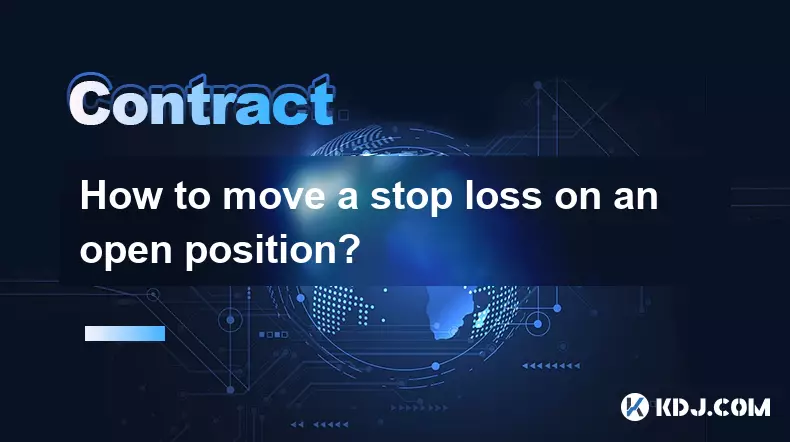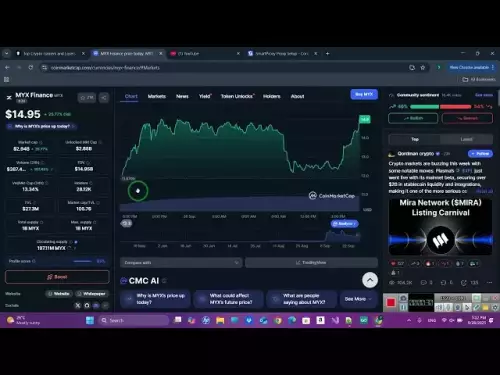-
 bitcoin
bitcoin $109547.008142 USD
0.04% -
 ethereum
ethereum $4011.838726 USD
-0.05% -
 tether
tether $1.000402 USD
-0.01% -
 xrp
xrp $2.798606 USD
0.88% -
 bnb
bnb $970.877944 USD
1.39% -
 solana
solana $202.237275 USD
-0.95% -
 usd-coin
usd-coin $0.999673 USD
0.00% -
 dogecoin
dogecoin $0.229294 USD
-1.15% -
 tron
tron $0.336370 USD
-0.45% -
 cardano
cardano $0.777260 USD
-1.66% -
 hyperliquid
hyperliquid $45.503019 USD
1.73% -
 ethena-usde
ethena-usde $1.000362 USD
0.01% -
 chainlink
chainlink $20.785303 USD
-1.10% -
 avalanche
avalanche $28.755822 USD
-0.11% -
 stellar
stellar $0.358303 USD
-0.48%
How to move a stop loss on an open position?
Adjusting your stop loss in crypto trading helps lock in profits and manage risk, especially in volatile 24/7 markets—use trailing stops or key technical levels for better protection.
Sep 15, 2025 at 03:18 pm

Moving a Stop Loss in a Crypto Trading Position
Adjusting a stop loss on an open position is a common practice among active traders in the cryptocurrency market. This technique allows traders to lock in profits, reduce risk exposure, or adapt to evolving market conditions. Unlike traditional financial markets, the crypto space operates 24/7, which increases volatility and necessitates more dynamic risk management strategies.
Steps to Modify a Stop Loss Order
1. Access your trading platform or exchange where the open position is held. Most major exchanges like Binance, Bybit, or Kraken offer stop loss adjustment features directly on their trading interfaces.
- Navigate to the 'Open Positions' or 'Active Orders' tab, locate the specific trade you wish to modify, and select the option to edit the stop loss.
- Enter the new price level at which you want the stop loss to trigger. Ensure this price aligns with current market structure, such as recent support or resistance zones.
- Confirm the change by submitting the updated order. Some platforms may require additional verification steps for risk management purposes.
- Monitor the position after the adjustment to ensure the new stop loss remains valid and isn’t canceled due to insufficient margin or market gaps.
Strategies for Optimizing Stop Loss Placement
1. Use trailing stop losses to automatically follow price movements. This tool adjusts the stop level as the market moves in your favor, protecting gains without requiring manual input.
- Set stop losses beyond key technical levels, such as below a recent swing low in an uptrend, to avoid premature liquidation from normal market noise.
- Consider volatility indicators like the Average True Range (ATR) to determine a realistic stop distance that accounts for crypto’s inherent price swings.
- Avoid placing stop losses at round numbers where market makers often cluster orders, as these levels are prone to being targeted by short-term price manipulation.
- Reassess stop loss levels after major news events or macroeconomic announcements that shift market sentiment.
Risks and Considerations When Adjusting Stops
1. Frequent adjustments can lead to emotional trading decisions. Moving stops too close to the current price may result in early exits during temporary retracements.
- In highly volatile markets, slippage can occur when a stop loss triggers, especially during flash crashes or pump-and-dump scenarios common in low-cap altcoins.
- Some decentralized exchanges or less liquid platforms may not support stop loss modifications, requiring traders to close and reopen positions manually.
- Over-tightening stop losses in leveraged positions increases the risk of liquidation, particularly in futures trading where margin requirements are strict.
- Ensure your internet connection and exchange stability are reliable before making changes, as delays can result in missed adjustments during fast-moving markets.
Frequently Asked Questions
Can I move my stop loss to break even after a trade becomes profitable?Yes, moving a stop loss to break even is a popular tactic to eliminate risk once a position has moved favorably. This ensures that even if the market reverses, the trader exits without a loss.
What happens if the market gaps past my stop loss level?In cases of extreme volatility, the price may skip over your stop loss level entirely. This results in execution at the next available price, which could lead to significant slippage, especially in illiquid tokens.
Is it possible to automate stop loss adjustments?Yes, many trading bots and advanced platforms support automated trailing stops or rule-based adjustments. These tools use predefined conditions to shift stop levels without manual intervention.
Do all cryptocurrency exchanges allow stop loss modifications?No, not all exchanges support this feature. Some smaller or decentralized platforms may only allow setting a stop loss at order placement, requiring traders to close and reopen positions to change levels.
Disclaimer:info@kdj.com
The information provided is not trading advice. kdj.com does not assume any responsibility for any investments made based on the information provided in this article. Cryptocurrencies are highly volatile and it is highly recommended that you invest with caution after thorough research!
If you believe that the content used on this website infringes your copyright, please contact us immediately (info@kdj.com) and we will delete it promptly.
- Digital Asset Treasuries, M&A, and the Crypto Berkshire Hathaway: A New Era
- 2025-09-29 02:25:14
- PEPE Price Prediction: Meme Coin Mania or Fading Fad?
- 2025-09-29 03:05:13
- HBAR, Crypto, Buy Now: Decoding the Hype and Finding the Real Gems
- 2025-09-29 03:05:13
- DeepSnitch AI: Your Crypto Fortune Teller for 2025?
- 2025-09-29 02:25:14
- Investors, Ethereum, and Citigroup: Navigating the Crypto Landscape in 2025
- 2025-09-29 03:18:09
- BlockchainFX, Dogecoin, and Crypto Coins: A New York Minute on the Future
- 2025-09-29 02:30:01
Related knowledge

How do I use the scheduled order feature in Cardano (ADA) contracts?
Sep 28,2025 at 10:18pm
Understanding Scheduled Orders in Cardano Smart ContractsCardano operates on a proof-of-stakes consensus mechanism and uses the Plutus scripting langu...

How do I enable the "scalping-only" mode for Cardano (ADA) contracts?
Sep 24,2025 at 03:19am
Understanding Scalping Strategies in Crypto Derivatives1. Scalping in cryptocurrency trading refers to executing multiple short-term trades within min...

What is the settlement time for Cardano (ADA) contracts?
Sep 28,2025 at 04:18am
Understanding Cardano's Contract Settlement Mechanism1. Cardano operates on a proof-of-stake consensus model known as Ouroboros, which fundamentally i...

How do I add margin to Cardano (ADA) contracts?
Sep 27,2025 at 07:54pm
Understanding Margin in Cardano (ADA) Smart ContractsCardano operates on a proof-of-stake blockchain that supports smart contracts through its Plutus ...

What is the maximum position limit for Cardano (ADA) contracts?
Sep 23,2025 at 11:00pm
Understanding ADA Futures and Derivatives Market Structure1. Cardano (ADA) futures contracts are offered by several major cryptocurrency derivatives e...

What is the maker fee for Cardano (ADA) contracts?
Sep 26,2025 at 09:01am
Understanding Maker Fees in Cardano (ADA) Contracts1. The concept of maker fees applies broadly across decentralized exchanges and smart contract plat...

How do I use the scheduled order feature in Cardano (ADA) contracts?
Sep 28,2025 at 10:18pm
Understanding Scheduled Orders in Cardano Smart ContractsCardano operates on a proof-of-stakes consensus mechanism and uses the Plutus scripting langu...

How do I enable the "scalping-only" mode for Cardano (ADA) contracts?
Sep 24,2025 at 03:19am
Understanding Scalping Strategies in Crypto Derivatives1. Scalping in cryptocurrency trading refers to executing multiple short-term trades within min...

What is the settlement time for Cardano (ADA) contracts?
Sep 28,2025 at 04:18am
Understanding Cardano's Contract Settlement Mechanism1. Cardano operates on a proof-of-stake consensus model known as Ouroboros, which fundamentally i...

How do I add margin to Cardano (ADA) contracts?
Sep 27,2025 at 07:54pm
Understanding Margin in Cardano (ADA) Smart ContractsCardano operates on a proof-of-stake blockchain that supports smart contracts through its Plutus ...

What is the maximum position limit for Cardano (ADA) contracts?
Sep 23,2025 at 11:00pm
Understanding ADA Futures and Derivatives Market Structure1. Cardano (ADA) futures contracts are offered by several major cryptocurrency derivatives e...

What is the maker fee for Cardano (ADA) contracts?
Sep 26,2025 at 09:01am
Understanding Maker Fees in Cardano (ADA) Contracts1. The concept of maker fees applies broadly across decentralized exchanges and smart contract plat...
See all articles









































































